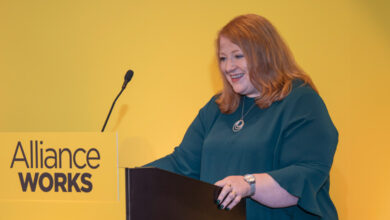Assembly business: Communications

Head of Communications for the Northern Ireland Assembly, Susie Brown, discusses the Assembly’s new communications strategy, including the role of social media in informing and engaging audiences.
Setting the context of a high-profile organisation under constant political and media scrutiny, Brown emphasises the critical nature of transparency and accountability in the Assembly’s communications.
Brown’s team has recently embarked on a strategy to embed a more planned approach to its what it publishes, how content is published and the creation of content.
“A strategy allows us to focus and give structure to our efforts,” explains Brown. “We can be very specific about what it is we want to achieve, with governance in place so that we know who is responsible for what and we have a workflow that helps us get from concept to publication, with structure.”
Outlining the benefits to the new approach, the Head of Communications says that efficiencies are achieved not only through enhanced role identification in the content production process, backed up with data and intelligence to support quick and efficient decisions, but also through the building of team empowerment.
“The benefits to our users are that they only receive high quality content, it is trustworthy, it is user-centred and it well help them to become champions to amplify our content,” she explains.
Brown outlines the core objectives of the Assembly’s communications strategy in supporting and demonstrating effective scrutiny and debate; helping to explain Assembly business and proceedings; and inspiring meaningful engagement and participation.
To this end, social media has been a valuable tool. The Assembly uses YouTube, Facebook, Twitter and Instagram as its core channels.
Outlining a number of core objectives, Brown explains that around scrutiny and debate, the Assembly seeks to amplify its own accurate, timely and accessible content in the form of what is happening in the chamber and in committees, supported by experts across the Assembly. Explanation of business and proceedings evolves around the sharing of text, video and audio content, showcasing activity and engaging in discussion with audiences. This engagement is part of the wider participation objective, which sees the Assembly facilitate meaningful engagement and signpost areas of possible participation such as visiting, campaign support and the influence of the Assembly’s work on peoples’ lives.
Discussing the implementation of these objectives, Brown explains that central to any ambitions is user need, with the Assembly utilising research and data to inform everything that it publishes. In particular, she points to moves to address misinformation, which requires educational and informative content.
“We focus on our core work and we use a small number of channels and we do them well, rather than spread ourselves too thinly,” she says, outlining that these channels are selected on the basis of where the Assembly’s audiences are.
“By providing content where our audiences are, it minimises our need to divert them to other sources which is important to build trust,” says Brown. “Equally important in this respect is that we have continuous iteration, meaning that my team keeps up to date with social media trends and keeps improving our content and our strategies. If something is not working, then we change it.”
Discussing the challenge of achieving unity without uniformity with content tailored for different audiences across different channels, Brown says: “We have a real collaboration culture at the Assembly, internally and externally. We generate ideas using the strength of all of our skills but we work with teams across the Assembly on joint projects and have an awareness of what others are doing.
“We are open in terms of what we share in terms of data, learning and we regularly meet with other teams to understand their needs and goals, identifying how we can help from a communications and a social media perspective.”
Describing the structure of content, Brown points to a range of content pillars which underpin the Assembly’s objectives. “Each of our six pillars has content which supports the delivery of each objective. In creating topics, we then look to see if the content exists and if it does, if we can use it or if it needs tailored. If it doesn’t exist, we look to see if we or a colleague can create it, what links we have to existing content and what we can re-use.”
Governance
Explaining that as a public body, governance is at the heart of all that the Assembly does and very important in relation to communications, Brown points to challenges in delivering at speed. Providing agility, the Assembly’s communications team has autonomy to create and publish content.
“We work in an environment of trust, professionalism and integrity,” she states.
“Our model is that the author will go through a period of discovery, they will work with a subject matter expert and create that content with appropriate research. We then get expert review prior to publication and post-publication, we review that content based on user experience, adding iterations where necessary.”
On the topic of measuring success, Brown points to a range of overarching key performance indicators (KPIs) used across all content but stresses the use of additional targets and metrics where necessary, on different objectives.
Things like audience growth rate, amplification rate and social share of voice are all tools used by the Assembly to gauge success of content. Brown is pleased to highlight results that showcase progression including 1.62 million Facebook impressions in the last year and 13.6 per cent increase in Twitter followers since September 2020.
However, she is aware of the stark difference between followers and an engaged audience and places greater weight on the impressive 9.6 per cent engagement rate for Facebook and 7.3 per cent rate for Twitter held by the Assembly over the past 12 months.
Brown admits that not all engagement with the Assembly is positive and so, her team has a strategy in place to deal with negativity which involves firstly, understanding the complaint or problem and its motivation, secondly, offering a quick, accurate and impartial response and thirdly, if necessary, passing the complaint on to the relevant body.
Brown adds the stipulation: “We never respond to threats, abusive communications or communication that includes swearing. Our tone is helpful and calm. Always.”
Concluding, Brown paid tribute to her team who continue to stay right up to date with the digital landscape and are never afraid to try new things to increase awareness of and participation with the Assembly.





